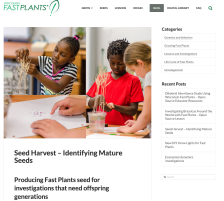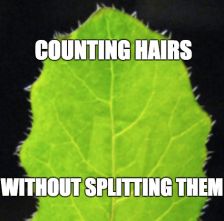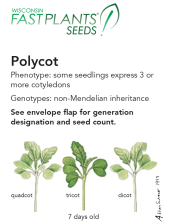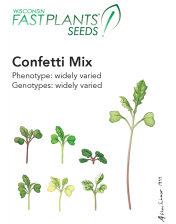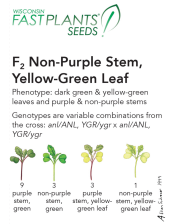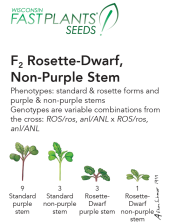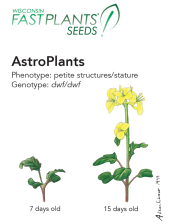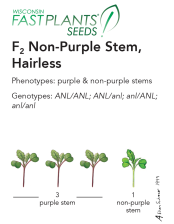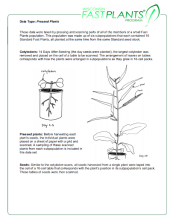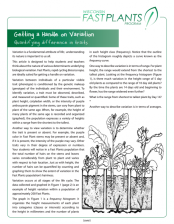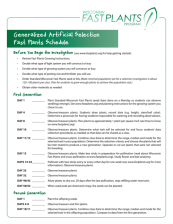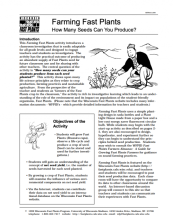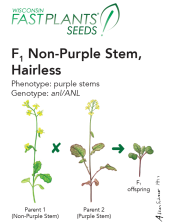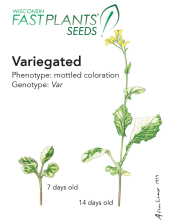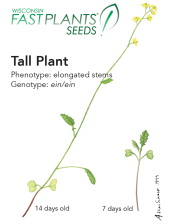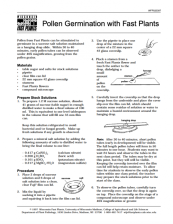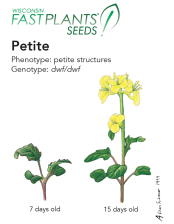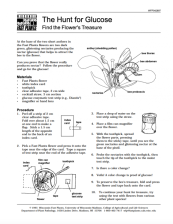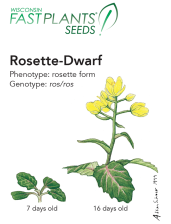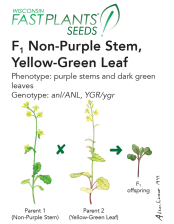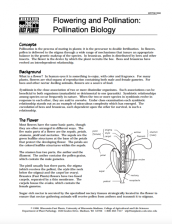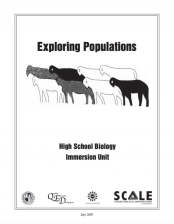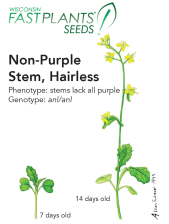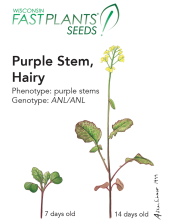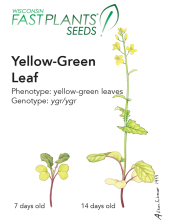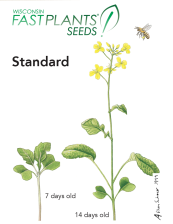Browse Resources
(2 classifications) (31 resources)
Educational Resources -- Grade Level: Undergraduate
| Classic Undergraduate Level Resources (developed before the year 2010)
(5)
Current Undergraduate Level Resources (12) |
Resources | |
|---|---|
This blog post from the Fast Plants team provides detailed advice and instructions on the ideal timing for harvesting Fast Plants seeds. It is important to harvest at the correct time, to ensure maximum seed viability for planting the next generation. This post addresses several frequently asked...
This blog post, written by the MiniPCR Team, describes the use of biotechnology kits and equipment (available from multiple suppliers) in the classroom to help students and learners understand the connection between observable phenotypic traits and underlying genotypes. These investigations can be...
This blog post from the Wisconsin Fast Plants website describes the observation of plant hairs (trichomes) for conducting a selective breeding experiment (such as in AP Biology investigations). The number of hairs is variable in Fast Plants seed varieties, and selection for or against plant...
This is a page on the Fast Plants website, describing the Polycot variety of Fast Plants (Brassica rapa). Two generations of the Polycot variety are available, each with a different % of expression of the polycot trait. This page includes suggestions for investigations and teaching applications...
This is a page on the Fast Plants website, describing the Confetti Seed Mix variety of Wisconsin Fast Plants (Brassica rapa). Confetti Mix includes phenotypes from several Fast Plants varieties, including purple stem, non-purple stem, yellow-green leaf, rosette-dwarf, tall plant, petite, variegated,...
This is a page on the Fast Plants website, describing the F2 Non-Purple Stem, Yellow-Green Leaf variety of Fast Plants (Brassica rapa). This page includes suggestions for investigations and teaching applications using this seed variety, including use as a model organism in teaching Mendelian...
This is a page on the Fast Plants website, describing the F2 Rosette-Dwarf, Non-Purple Stem variety of Fast Plants (Brassica rapa). This page includes suggestions for investigations and teaching applications using this seed variety, including use as a model organism in teaching Mendelian genetics...
This is a page on the Fast Plants website, describing the F1 Rosette-Dwarf, Non-Purple Stem variety of Fast Plants (Brassica rapa). This page includes suggestions for investigations and teaching applications using this seed variety, including use as a model organism in teaching Mendelian genetics...
This is a page on the Fast Plants website, describing the AstroPlants variety of Fast Plants (Brassica rapa). This page includes suggestions for investigations and teaching applications using this seed variety.
This is a page on the Fast Plants website, describing the F2 Non-Purple Stem variety of Fast Plants (Brassica rapa). This page includes suggestions for investigations and teaching applications using this seed variety, including use as a model organism in teaching Mendelian genetics with a monohybrid...
Sign up for a free account on the Gizmo website (https://www.explorelearning.com/index.cfm?method=Controller.dspFreeAccount) for free access to two simulations that were collaboratively developed by the teams at Explore Learning and the Wisconsin Fast Plants Program of the University of...
These data sets were meticulously collected by Dr. Paul Williams in an investigation in which we were interested in learning about how nutrient limitations effect a variety of easily observable and measureable Fast Plant traits. Observations were made and recorded at different points in the plants'...
This article is designed to help students and teachers think about the nature of various determinants underlying biological variation. Teachers facilitating any selection investigation will find this background information helpful, including those planning for the AP Biology Lab 1 of Big Idea 1:...
This fill-in-the-blank timeline is a planning tool for teachers to use when figuring out when to begin the steps associated with conducting a two-generation artificial selection experiment using Fast Plants. Teachers preparing for any selection experiment will find this timeline helpful, including...
This Farming Fast Plants activity introduces a classroom investigation that is easily adaptable for all grade levels and designed to engage teachers and students as investigators. The activity has the practical outcome of producing an abundant supply of Fast Plants seed for future classroom use and...
This is a page on the Fast Plants website, describing the F1 Non-Purple Stem variety of Fast Plants (Brassica rapa). This page includes suggestions for investigations and teaching applications using this seed variety, including use as a model organism in teaching Mendelian genetics with a monohybrid...
This is a page on the Fast Plants website, describing the Non-Purple Stem, Yellow-Green Leaf variety of Fast Plants (Brassica rapa). This page includes suggestions for investigations and teaching applications using this seed variety.
This is a page on the Fast Plants website, describing the Variegated variety of Fast Plants (Brassica rapa). This page includes suggestions for investigations and teaching applications using this seed variety.
This is a page on the Fast Plants website, describing the Tall Plant variety of Fast Plants (Brassica rapa). This page includes suggestions for investigations and teaching applications using this seed variety.
Protocol for germinating Fast Plants pollen in a sucrose-salt solution
This is a page on the Fast Plants website, describing the Petite variety of Fast Plants (Brassica rapa). This page includes suggestions for investigations and teaching applications using this seed variety.
Background information and activity investigating the Fast Plant nectaries and their functions.
This is a page on the Fast Plants website, describing the Rosette-Dwarf variety of Fast Plants (Brassica rapa). This page includes suggestions for investigations and teaching applications using this seed variety.
This is a page on the Fast Plants website, describing the F1 Non-Purple Stem, Yellow-Green Leaf variety of Fast Plants (Brassica rapa). This page includes suggestions for investigations and teaching applications using this seed variety, including use as a model organism in teaching Mendelian...
Turnips, Chinese cabbage and Wisconsin Fast Plants (Rbr) look very different. Yet, they actually belong to the same species. This means that they have the same number of chromosomes and they can cross breed and produce fertile offspring. But how can you prove that plants that look so different are...
This pdf includes background information and an activity for engaging students in the processes that occur during pollination, fertilization and seed development in Fast Plants. Pollination is explained and illustrated and an activity for students to pollinate Fast Plants and observe reproductive...
This Immersion Unit provides a coherent series of lessons designed to guide students in developing deep conceptual understanding that is aligned with the standards, key science concepts, and essential features of classroom inquiry (as defined by the National Science Education Standards).
Unit...
This is a page on the Fast Plants website, describing the Non-Purple Stem Hairless variety of Fast Plants (Brassica rapa). This page includes suggestions for investigations and teaching applications using this seed variety.
This is a page on the Fast Plants website, describing the Purple Stem, Hairy variety of Fast Plants (Brassica rapa). This page includes suggestions for investigations and teaching applications for using this seed variety.
This is a page on the Fast Plants website, describing the Yellow-Green Leaf variety of Fast Plants (Brassica rapa). This page includes suggestions for investigations and teaching applications using this seed variety.
This is a page on the Fast Plants website, describing the Standard variety of Wisconsin Fast Plants (Brassica rapa). This page includes suggestions for investigations and teaching applications using this seed variety, including use as a model organism to teach about the plant life cycle and plant...
| |
